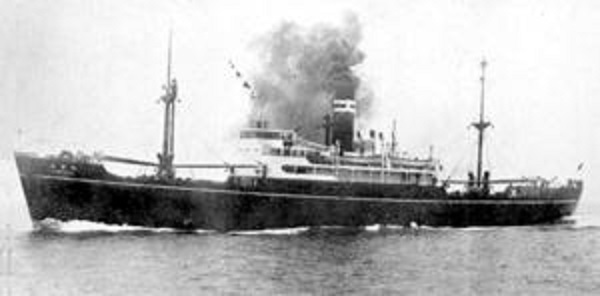KOKAI HOKAN!
 (KANKO MARU, prewar)
(KANKO MARU, prewar)
IJN KANKO MARU:
Tabular Record of Movement
© 2022 Gilbert Casse, Berend van der Wal and Peter Cundall
6 April 1938:
Uraga. Laid down by Uraga Senkyo K.K. Uraga Kojo as a 2,929-tons cargo ship for Osaka Shosen K.K. (OSK).
16 August 1938:
Launched and named KANKO MARU. [1]
18 November 1938:
Completed and registered at Osaka. Her Gross Registered tonnage (GRT) and Net Registered Tonnage (NRT) respectively are 2,723-tons and 1,671-tons. Her call sign is JFYM. [2]
7 January 1939:
Departs Kobe on the Chosen (Korea) Express Line (Scheduled).
22 January 1939:
Departs Kobe on the Chosen Express Line (Scheduled).
15 September 1940:
Requisitioned by the IJN.
15 October 1940:
Aioi. Registered as an auxiliary gunboat and minelayer attached to the Sasebo Naval District under instruction No. 716. Capt. Hijioka Torajiro is appointed CO. Conversion for military duty begins at Harima Zosensho K.K.
15 November 1940:
Rerated as an auxiliary gunboat under instruction No. 830. Attached to the 1st Gunboat Division under instruction No. 837. Navy (Resv) LtCdr. Tsuchiyama Tokichi is appointed CO.
26 November 1940:
Conversion for military duty is completed.
27 December 1940:
Rated as auxiliary gunboat No. 11 under First Base Force Instruction No. 47.
15 January 1941:
Designated as an auxiliary gunboat engaged in minelaying under instruction No. 56.
23 March 1941:
Departs Tokuyama, Yamaguchi Prefecture for Naka waters.
4 April 1941:
Arrives at Karatsu, Saga Prefecture, Kyushu.
1 May 1941:
Navy (Resv) LtCdr. Noguchi Yasukazu is appointed CO.
10 June 1941:
Departs Sasebo for southern Chinese waters.
8 July 1941:
Arrives at Mako, Pescadores (now Makung, Penghu, Taiwan).
12 July 1941:
Departs Takao, Formosa (now Kaoshiung, Taiwan) for southern Chinese waters.
7 September 1941:
Arrives at Sasebo.
15 October 1941:
1st Gunboat Division is formed under instruction No. 1250. Attached to Vice Admiral Takahashi Ibo’s (36) Third Fleet, First Base Force, 1st Gunboat Division.
8 December 1941:
Arrives at Koniya, Amami Oshima.
17 December 1941: The Invasion of Lamon Bay, Quezon, Philippines:
Imperial General Headquarters launches the combined IJA and IJN Lamon Bay Operation. The Army force consists of Gen (later Field Marshal) Count Terauchi Hisachi’s Southern Expeditionary Army. Its 14th Army, under LtGen Homma Masaharu, fields MajGen Morioka Susumu's Invasion Unit of about 7,000 troops consisting of elements of the 16th Infantry division: 20th Infantry, 22nd Field Artillery, HQ and II Battalion, 16 HQ Coy, 16th Eng Battalion, 16th Recon Battalion, 3/45 AA Coy, 16th Transport, 16th Signal Coy, 16th Med Unit and 16th Vet Unit. Two AA and one Signals Regiment are stationed on IJA transports.
The invasion units are embarked on 20 IJA transports: BENGAL, DAINICHI, DURBAN, KAIMEI, KAYO, KITANO, KOFUKU, LISBON, NAGATO, NICHIREN, RYOKA, RYUYO, SHINSEI, SHINSHU (4,182 GRT), TAIAN, TATSUNO, TOFUKU, TOYAMA and TOYOHASHI MARUs and TAMON MARU No. 5.
The naval force consists of Vice Admiral (later Admiral) Kondo Nobutake's (35) (former CO of KONGO) Southern Force, Philippines Invasion Group that includes Vice Admiral Takahashi Ibo’s (36) (former CO of YAMASHIRO) Third Fleet. Rear Admiral (later Vice Admiral) Kubo Kyuji’s (38) (former CO of KAGA) Invasion Unit consists of his 1st Base Force HQ, in light cruiser NAGARA, 1st Quartermaster Ports and Docks Unit and 1st Naval Signal Unit, aboard HAKUSAN MARU, 1st Naval Guard Unit, aboard KIMISHIMA MARU, 1st Naval Survey Unit in SENKO MARU and Captain (later Vice Admiral) Mori Kunizo's (40) (former CO of SATA) Sasebo No. 1 and 2 Combined Special Naval Landing Force (SNLF) aboard MYOKO MARU.
The convoy’s escort consists of light cruiser NAGARA (F), heavy cruiser ASHIGARA, destroyers TOKITSUKAZE, YUKIKAZE, KAWAKAZE, SUSUKAZE, UMIKAZE, YAMAKAZE, minelayer AOTAKA, minesweepers W-7 and W-8, auxiliary gunboat/minelayer IKUSHIMA MARU, auxiliary gunboats BUSHO, KEIKO, KANKO and MYOKEN MARUs, auxiliary subchasers SHONAN MARU No. 17 and TAKUNAN MARU No. 5 and auxiliary netlayer FUKUEI MARU No. 15.
Departs Koniya, Amami Oshima with the invasion force for Lamon Bay.
24 December 1941:
Arrives with the invasion force at Lamon Bay.
26 December 1941:
Departs Lamon Bay.
1 January 1942:
Arrives at Palau, Western Carolines.
3 January 1942:
Departs Palau.
8 January 1942:
Arrives at Malalag Bay, Davao Gulf, Philippines.
10 January 1942:
Departs Malalag Bay alone. Off Cape San Augustin, Philippines in position 06-19N, 125-54E at 0805, LtCdr. Barton E. Bacon (USNA '25), Jr’s USS PICKEREL (SS-177) fires 3 torpedoes of which two hit. KANKO MARU starts listing to port and settles to the bow. The plating on the port side under the bridge is stoved in. KANKO MARU fires all of her guns continuously. The submarine departs and continues her patrol. At 1530, Bacon sights the burning KANKO MARU and 3 small destroyers coming S from Davao. USS PICKEREL dives and clears the area. At 1710, only smoke is in sight. Later this evening, after a large internal explosion, KANKO MARU sinks at 06-12N, 125-55E about 12.4 nautical miles ENE Callian Point at Davao Bay’s entrance. Two crewmen are killed in the initial attack.
31 January 1942:
Removed from the Navy’s list under instruction No. 176.
Authors' Notes:
[1] Not to be confused with civilian cargo ship (2,911 GRT, ’03), IJA transport No. 457 (1,283 GRT, ’18) and auxiliary netlayer (909 GRT, ’41).
[2] NRT is a ship's cargo volume capacity expressed in "register tons", one of which equals to a volume of 100 cubic feet (2.83 m3). It is calculated by subtracting non-revenue-earning spaces i.e. spaces not available for carrying cargo, for example engine rooms, fuel tanks and crew quarters, from the ship's gross register tonnage (GRT). Net register tonnage (NRT) is not a measure of the weight of the ship or its cargo, and should not be confused with terms such as deadweight tonnage or displacement.
Thanks go to Gengoro S. Toda of Japan.
- Gilbert Casse, Berend van der Wal and Peter Cundall.
Back to the Auxiliary Gunboats Page





